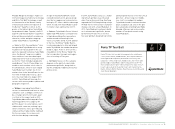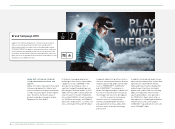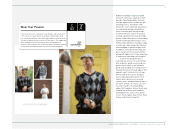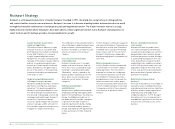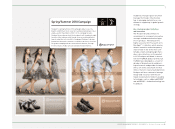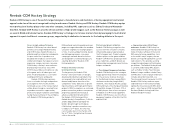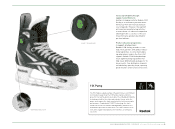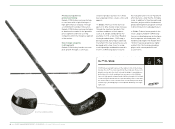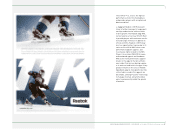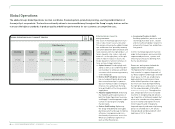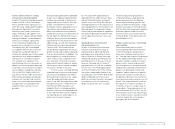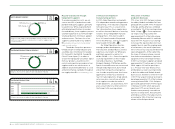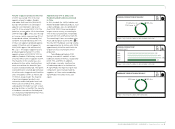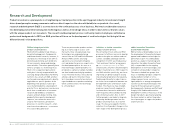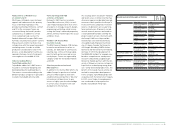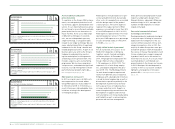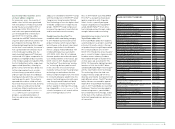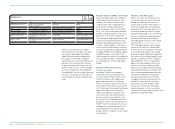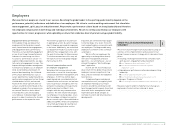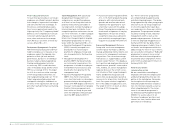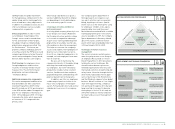Reebok 2009 Annual Report Download - page 93
Download and view the complete annual report
Please find page 93 of the 2009 Reebok annual report below. You can navigate through the pages in the report by either clicking on the pages listed below, or by using the keyword search tool below to find specific information within the annual report.
Further advancements in costing
transparency and predictability
In light of the decline of global economic
output, our End-to-End Profitability
efforts gained further significance in
2009. We set up a dedicated Profitability
Management department to monitor
macroeconomic trends, forecast the
impact on product and supplier costs,
and devise our supply chain profitability
strategy. In addition, our development
teams also contribute significantly
to this initiative by engineering our
product with a stronger focus on cost.
Throughout 2009, we also engaged
our suppliers with the aim to increase
transparency and predictability in
costing. For example, we closely tracked
raw material costs and leveraged this
information to consolidate volumes.
This allowed us to negotiate more
effectively and offset cost increases. In
addition, our Sourcing teams improved
our product allocation process to better
utilise suppliers’ capabilities and take
into account total supply chain costs
(e.g. time to market, trade restrictions).
Moreover, by leveraging consolidated
volumes, our Transport and Customs
team successfully negotiated reduced
transportation costs and optimised
shipment routes with our service
providers.
Infrastructure optimisation continued
As part of our Adaptive Supply Network
initiative, we continued to optimise our
supply chain infrastructure in 2009. We
further consolidated our network of
distribution centres, upgraded our exist-
ing facilities and invested in new sites.
Apart from warehousing consolidation
and warehouse processes optimisation in
the UK, Spain, the Netherlands, Greece
and South Africa, our most remarkable
improvement was the finalisation of the
adidas Group’s
second multi-brand dis-
tribution centre in Spartanburg/South
Carolina, USA. These new facilities
are designed to support both the future
growth of our brands and future demands
from our retail channels. In addition, the
planning phase for a new distribution
centre in Russia was completed. How-
ever, execution of the project has been
deferred until market conditions require
that the project be re-started to support
our business models in the area.
In 2009, we also continued building
and enhancing our process and systems
infrastructure, bringing increased flex-
ibility and responsiveness to our supply
chain. We made significant enhance-
ments to our SAP-based purchase order
management system – Global Procure-
ment System (GPS) – based on user
feedback. We also started preparation
work for its rollout to the Reebok brand
in 2010. GPS harmonises and simplifies
the ordering process and enables us to
better react to market changes.
It is the largest SAP implementation
undertaken by the adidas Group to date,
and will ultimately replace ten legacy
systems across the Group. We have also
started preparations for the expansion of
our trading platform in Amsterdam to the
USA and Japan. The improved visibility,
control and risk management capabilities
this platform generates will benefit each
of our supply chain functions across all
brands.
Standardisation and automation
of planning processes
As part of our End-to-End Planning
initiative we have been focusing on
implementing an optimised demand
planning process and system to more
than 20 countries in Europe. We stand-
ardised and partially automated certain
planning functions to increase forecast
accuracy. Following the first wave of
implementations in 2008, we continued
the roll-out to the remaining European
countries throughout 2009. The final go-
live will be completed by the end of the
second quarter of 2010 when both brands
adidas and Reebok will share a joint
platform in Europe. Hereafter, we expect
to continue the roll-out to other key
adidas Group markets such as Japan.
GROUP MANAGEMENT REPORT – OUR GROUP Global Operations 89
The demand planning programme is
complemented by a supply planning
programme aimed at consolidating
several legacy planning systems and
processes within the Group into a single
International Logistics Planning System
(ILS) for all brands and product segments
(Footwear, Apparel and Accessories).
In 2009, ILS was successfully launched
for brand adidas. It will be rolled out for
brand Reebok in 2010.
Product creation process streamlined
and simplified
The Accelerated Creation to Shelf
initiative gained important momentum
in 2009 with progress being made in
three areas. February saw the start of
our “Fast and Lean Creation” programme
for the adidas and Reebok brands. It is
aimed at making our product creation
process faster, smarter and more effi-
cient through process streamlining and
simplification, improved communication
between our development teams and
suppliers, and the reduction of adminis-
trative work along the creation process.
An additional objective is the harmonisa-
tion of processes and systems across our
brands. This programme will accelerate
the expansion of creation calendars of
12 months or less to a larger share of
our products. The programme roll-out
will continue until 2011. In 2009, we also
increased the use of virtual technologies
at our creation centres around the world
to further reduce the cost of product
proto types and sales samples.


